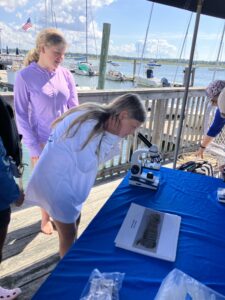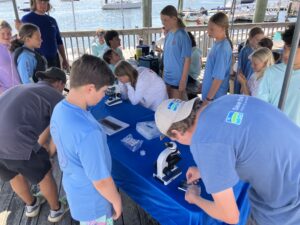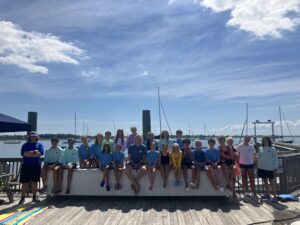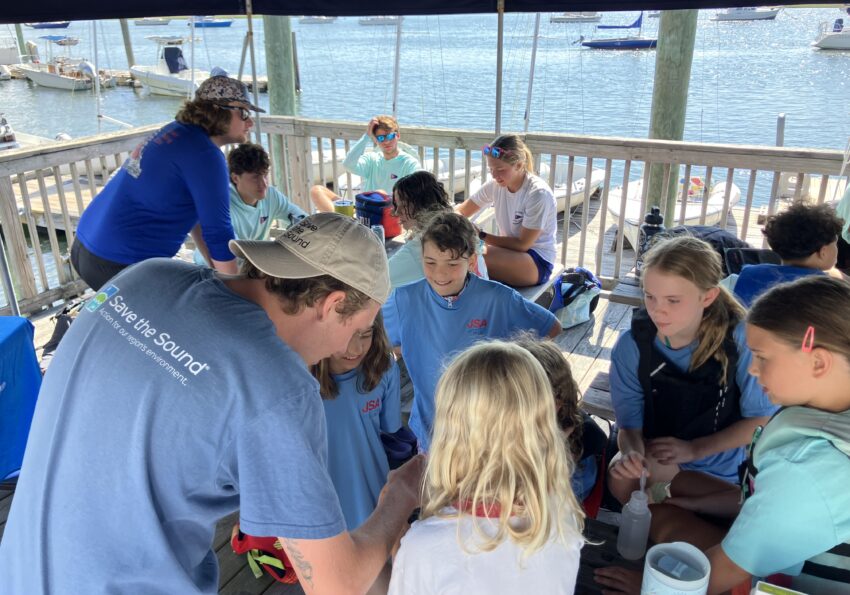Save the Sound & JSA of LIS together for a Second Year of Environmental Programming
written by Erin Wojdaszka
Save the Sound (STS) and the JSA came together for a second year to present an easy way to incorporate learning about the water and your local environment. This year the Sound Advocates session focused on plankton, crustaceans, and water quality. Most of the lesson was interactive, getting sailors engaged with the micro-organisms in the water around them. We talked about pollution, climate change, the water cycle, invasive species, and more during the two-hour sessions. The program combined classroom learning with hands-on activities on the docks, allowing sailors to directly connect their sailing activities with environmental awareness.
 On July 23rd I had the pleasure of joining Adi Kolff at Housatonic Boat Club. After graduating from college, Adi had the opportunity to work as a summer intern with the Save the Sound team in the Larchmont, NY office to teach junior sailors about their local environment. Many yacht clubs have signed up to be a part of this program and incorporate it into their junior sailing programs. Adi said, “ It was amazing to see how many programs were interested in what we could teach to their sailors and how interactive the sailors were throughout his sessions.” He has visited many clubs with all different kinds of programs and has worked with different ages.
On July 23rd I had the pleasure of joining Adi Kolff at Housatonic Boat Club. After graduating from college, Adi had the opportunity to work as a summer intern with the Save the Sound team in the Larchmont, NY office to teach junior sailors about their local environment. Many yacht clubs have signed up to be a part of this program and incorporate it into their junior sailing programs. Adi said, “ It was amazing to see how many programs were interested in what we could teach to their sailors and how interactive the sailors were throughout his sessions.” He has visited many clubs with all different kinds of programs and has worked with different ages.
Housatonic Boat Club is a small club near the mouth of the Housatonic river with about 29 sailors. Adi did a great job involving each of the sailors even though there was a large age range of 8 to 15 years HBC Junior Sailing Head Instructor Logan put the sailors into groups prior to getting the activities started. There were a total of 4 groups varying in sizes between 4-6 kids. All the groups interacted well and were engaged at different times throughout the activities.
Adi used questions such as: What is it? How was it formed? Is it part of the ocean? Where are we today? And describing how water cycles in and out of the LIS: What does it mean when an ecosystem is brackish? What is the saltwater source? What is the freshwater source? Contaminants can come from all over the northeast, not just our local communities. 
These questions helped Adi get an idea of what the sailors knew about the LIS. There were several activities that focused on different topics related to the Long Island Sound.. The activities included, “Trash in the Sound”, in which Adi used a poster that explains how long it takes for trash to break down in saltwater, helps the sailors realize how important it is to remember that trash doesn’t just disappear.
He asked them what microplastics are? Where do the components that make up plastic waste end up? He had the kids guess how long it takes for things to break down, this helps keep them engaged. Some of the other topics are; introducing plankton, phytoplankton vs. zooplankton, explaining common crustaceans in the LIS (blue crab, horseshoe crab, hermit crab, lobster, mantis shrimp), lobster traps, and finally water quality.
As part of the afternoon’s adventure, Adi invited the sailors to channel their inner scientists. Working in lively crews, each group set out to collect its very own water sample—like a mini treasure hunt on the water. A few careful drops were placed onto microscope slides, and the real voyage began: the exploration of a hidden, miniature world. Every crew uncovered something unique beneath the lens, but one team even discovered a tiny organism navigating through its slide. Laughter and good-natured banter filled the dock as the sailors took turns peering at each other’s finds and swapping discoveries. When the day’s activities concluded, the sailors offered Adi a hearty thanks, struck a proud pose for a group photo, and sealed the day’s memories with smiles all around.



